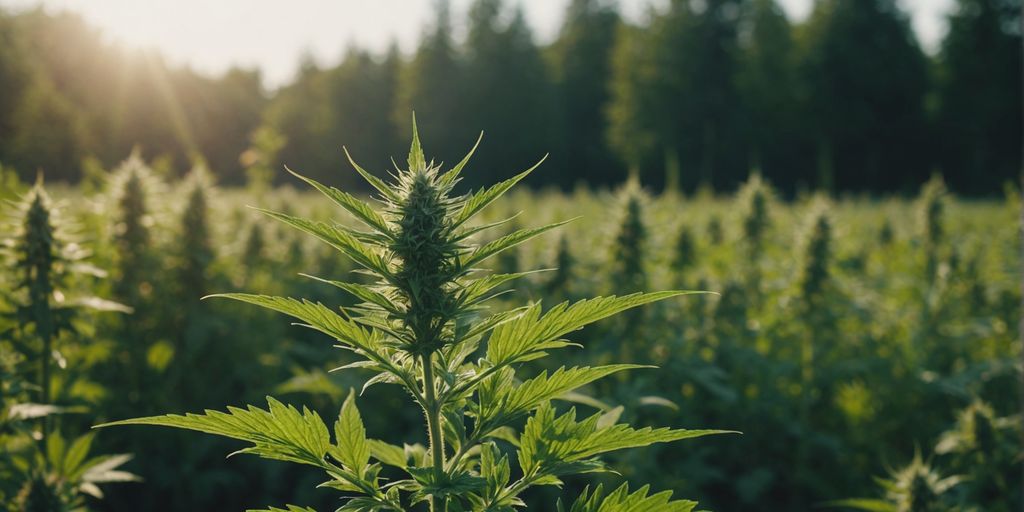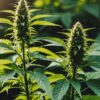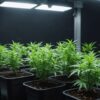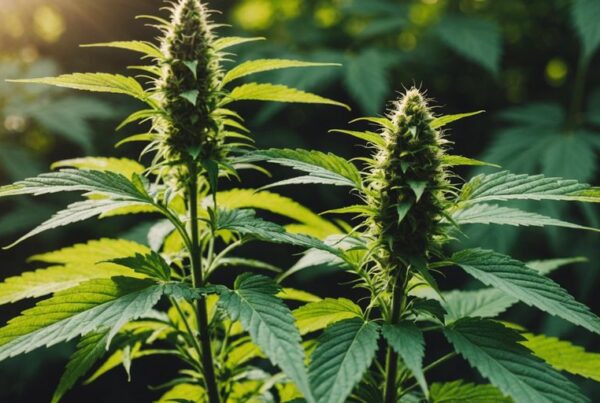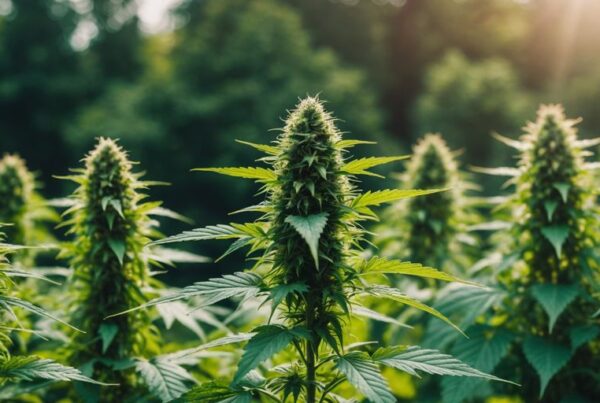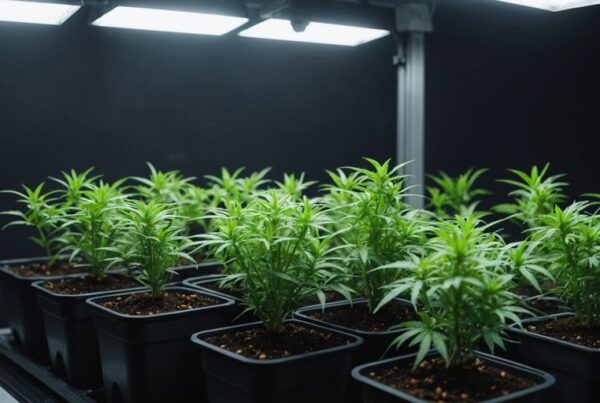Training your weed plants is a simple and affordable way to boost your harvest. By using different training methods, you can increase your yields by up to 40%. This guide will walk you through various techniques to help you get the most out of your cannabis plants.
Key Takeaways
- Plant training can increase cannabis yields by up to 40%.
- Low Stress Training (LST) involves gently bending and securing plant parts.
- High Stress Training (HST) includes techniques like topping and supercropping.
- The Screen of Green (ScrOG) method uses a screen to spread out plant branches.
- Combining different training techniques can lead to the best results.
Understanding Weed Plant Training
Definition and Importance
Training cannabis plants involves changing or manipulating their physical structure to help them produce more branches capable of growing large top colas. Naturally, cannabis plants grow in a singular-stalk or Christmas-tree shape. This natural structure optimizes sunlight absorption but usually results in one large bud and many smaller buds on the lower part of the plant.
Benefits of Training
Training your cannabis plants can lead to several benefits:
- Increased yield: More branches mean more buds.
- Better light exposure: Training helps the plant’s canopy get more light.
- Improved airflow: Proper training can enhance airflow around the plant, reducing the risk of mold and pests.
Common Misconceptions
There are many myths about cannabis yield-boosting tactics. Some people think training is too complicated or risky. However, with the right techniques, even beginners can successfully train their plants and see significant improvements in yield and plant health.
Training is a simple yet effective way to boost your cannabis yield without needing to upgrade your grow lights or system.
Low Stress Training (LST) Techniques
Low Stress Training (LST) is a gentle way to shape your cannabis plants without causing them much stress. The main idea is to bend and tie down the stems to create a flat and wide shape. This helps the plant get more light and grow more buds.
Step-by-Step Guide
- Start when the plant is young and its stems are still flexible.
- Gently bend the tall stems away from the center of the plant.
- Use wires, strings, or yo-yos to secure the stems in place.
- Keep adjusting as the plant grows to maintain the shape.
Best Practices
- Always be gentle to avoid breaking the stems.
- Regularly check and adjust the ties to ensure they are not too tight.
- Monitor the plant’s response and make changes as needed.
Common Mistakes
- Starting LST too late when the stems are already woody and hard to bend.
- Tying the stems too tightly, which can damage the plant.
- Not adjusting the ties as the plant grows, leading to restricted growth.
High Stress Training (HST) Methods
High Stress Training (HST) involves intentionally stressing the plant by cutting or bending branches to manipulate its shape and increase the overall yield. This method can be more intense for the plant and may increase the risk of damage, but can result in a higher yield.
Screen of Green (ScrOG) Method
The Screen of Green (ScrOG) method is a straightforward yet effective way to boost your cannabis yield. It involves using a mesh screen to train your plant’s stems to grow through the holes in the mesh. This technique helps create a flat canopy, making it easier for grow lights to reach all parts of the plant and providing support for the buds as they mature.
Setting Up the Screen
To set up a ScrOG, you’ll need a netted screen made of materials like chicken wire, rope, or nylon netting. Place the screen above your plants and adjust its height as the plants grow. The goal is to keep the height of the cannabis plants contained and to increase the number of buds produced.
Training the Plants
As your plants grow, gently guide the branches through the holes in the screen. This will help create an even canopy and expose more branches to light. The main objective is to have as many main colas as possible, thereby increasing yield. This method is almost like a combination of the Sea of Green (SOG) and Low Stress Training (LST) techniques.
Advantages of ScrOG
- Maximizes light exposure
- Controls plant height
- Increases the number of bud sites
- Provides support for heavy buds
Screen of Green is a way to maximize yields while using the minimum number of plants. This technique uses topping, trellis, or stakes to achieve a flat canopy.
Defoliation Strategies
When to Defoliate
Defoliation involves removing fan leaves in a strategic way in the first part of the flowering stage. The key is to do this at the right time and to the right degree. You only defoliate right before the switch to the flowering stage. And once or twice during the flowering stretch period, when the plant is undergoing its most rapid growth.
How to Defoliate
- Initial Defoliation: Remove the largest fan leaves to expose bud sites and improve light penetration.
- Follow-up Defoliation: Conduct another round of defoliation during the first few weeks of the flowering stage.
Impact on Yield
Defoliation can help buds grow bigger by exposing them to more light. However, exercise caution and avoid excessive defoliation that may stress the plant.
This experiment aims to test whether flowering stage defoliation increases or decreases cannabis yields overall.
Combining Techniques for Maximum Yield
Integrating LST and HST
Combining Low Stress Training (LST) and High Stress Training (HST) can significantly boost your cannabis yield. LST involves gently bending and tying down branches, while HST includes techniques like topping and supercropping. By integrating these methods, you can optimize the growth and yielding capacity of marijuana plants. Here’s a simple way to combine them:
- Start with LST during the early vegetative stage to shape the plant.
- Introduce HST methods like topping once the plant is strong enough.
- Continue with LST to maintain an even canopy.
Using ScrOG with Other Methods
The Screen of Green (ScrOG) method can be effectively combined with both LST and HST. ScrOG involves using a screen to spread out the plant’s branches, ensuring even light distribution. To maximize yield:
- Set up the screen early in the vegetative stage.
- Use LST to guide branches through the screen.
- Apply HST techniques to promote bushier growth.
Tailoring Techniques to Strain Type
Different cannabis strains respond uniquely to training techniques. It’s essential to tailor your approach based on the strain’s characteristics. For instance, sativa strains may benefit more from LST due to their tall and lanky nature, while indica strains might respond better to HST. Experimentation is your ally in finding the perfect balance for each strain.
Remember, each strain is unique, and what works best for one may not be ideal for another. Patience and practice will help you find the right combination of techniques to maximize your yield.
Avoiding Common Pitfalls in Weed Plant Training
Training weed plants can be tricky, especially for beginners. But if you can avoid the most common mistakes, you can learn much faster. Here are some tips to help you steer clear of common pitfalls.
Overtraining Risks
One of the biggest mistakes is overtraining your plants. This can stress them out and stunt their growth. It’s important to know when to stop and let your plants recover.
Monitoring Plant Health
Always keep an eye on your plants’ health. Look for signs of stress, like yellowing leaves or slow growth. If you notice any issues, adjust your training methods accordingly.
Adjusting Techniques Based on Plant Response
Every plant is different, so what works for one might not work for another. Pay attention to how your plants respond to training and be ready to change your approach if needed.
Mistakes are normal, and no grower is perfect; so they are somewhat inevitable. But, there are ways to help you avoid common mistakes when you train cannabis plants.
Conclusion
Training your cannabis plants is one of the simplest and most cost-effective ways to boost your harvest. By using techniques like Low Stress Training, High Stress Training, and strategic pruning, you can increase your yields by up to 40%. Even if you’re new to growing, these methods are easy to learn and can make a big difference. So, whether you’re growing indoors or outdoors, give plant training a try and see the benefits for yourself. Happy growing!
Frequently Asked Questions
What is weed plant training?
Weed plant training is a way to change how your cannabis plants grow. By bending or cutting parts of the plant, you can help it grow more buds and give you a bigger harvest.
Why is training weed plants important?
Training weed plants is important because it can increase your harvest by up to 40%. It also helps plants grow stronger and healthier.
What is Low Stress Training (LST)?
Low Stress Training, or LST, is a method where you gently bend the plant’s branches to spread them out. This helps more light reach all parts of the plant, making it grow more buds.
What is High Stress Training (HST)?
High Stress Training, or HST, involves more intense techniques like cutting the plant’s top or bending its branches until they almost break. This can make the plant grow more branches and buds.
What is the Screen of Green (ScrOG) method?
The Screen of Green, or ScrOG, method uses a screen to spread out the plant’s branches. This helps all parts of the plant get enough light, leading to a bigger harvest.
When should I start training my weed plants?
You should start training your weed plants when they are young and flexible. This is usually a few weeks after they have started growing.

